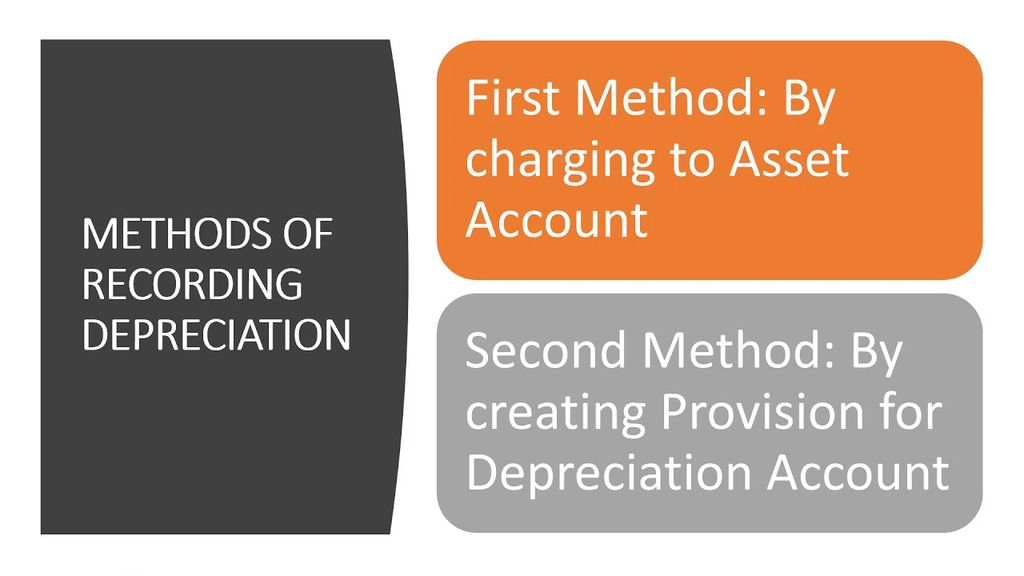- Books Name
- Vision classes Accountancy Book
- Publication
- Vision classes
- Course
- CBSE Class 11
- Subject
- Accountancy
Methods of recording Depreciation
There are two types of recording depreciation on fixed assets:

Charging Depreciation to Asset account
In this method, depreciation is deducted from the depreciable cost of the asset (credited to the asset account) and charged (or debited) to profit and loss account.
Journal entries under this recording method are as follows:
For recording purchase of asset
(only in the year of purchase) Asset A/c Dr. (with the cost of asset including installation, freight, etc.)
To Bank/Vendor A/c
Following two entries are recorded at the end of every year-
(a) For deducting depreciation amount from the cost of the asset.
Depreciation A/c Dr. (with the amount of depreciation)
To Asset A/c
(b) For charging depreciation to profit and loss account.
Profit & Loss A/c Dr. (with the amount of depreciation)
To Depreciation A/c
Balance Sheet Treatment:
In this method, the fixed asset appears at its net book value (i.e. cost less depreciation charged till date) on the asset side of the balance sheet and not at its original cost (also known as historical cost).
Creating Provision for Depreciation Account/Accumulated Depreciation Account
It is use to accumulate the depreciation provided on an asset in a separate account generally called 'Provision for Depreciation' or 'Accumulated Depreciation' account. By such accumulation of depreciation the asset account need not be disturbed in any way and it continues to be shown at its original cost over the successive years of its useful life.
There are some basic characteristic of this method of recording depreciation. These are given below:
- Asset account continues to appear at its original cost year after year over its entire life;
- Depreciation is accumulated on a separate account instead of being adjusted in the asset account at the end of each accounting period.
For recording purchase of asset.
(only in the year of purchase) Asset A/c Dr. (with the cost of asset including installation, expenses etc.)
To Bank/Vendor A/c (cash/credit purchase)
Following two journal entries are recorded at the end of each year:
(a) For crediting depreciation amount to provision for depreciation account.
Depreciation A/c Dr. (with the amount of depreciation)
To Provision for depreciation A/c
(b) For charging depreciation to profit and loss account.
Profit & Loss A/c Dr. (with the amount of depreciation)
To Depreciation A/c
Balance sheet treatment
In the balance sheet, the fixed asset continues to appear at its original cost on the asset side. The depreciation charged till that date appears in the provision for depreciation account, which is shown either on the "liabilities side" of the balance sheet or by way of deduction from the original cost of the asset concerned on the asset side of the balance sheet.
Disposal of Asset
Disposal of asset can take place either at the end of its useful life or during its useful life (due to obsolescence or any other abnormal factor).
If it is sold at the end of its useful life, the amount realised on account of the sale of asset as scrap should be credited to the asset account and the balance is transferred to profit and loss account.
Use of Asset Disposal Account
Asset disposal account is designed to provide a complete and clear view of all the transactions involved in the sale of an asset under one account head. The concerned variables are the original cost of the asset, depreciation accumulated on the asset up to date, sale price of the asset, value of the parts of the asset retained for use, if any and the resultant profit or loss on disposal. The balance of this amount is transferred to the profit and loss account. This method is generally used when a part of the asset is sold and provision for depreciation account exists.
In this method, a new account titled Asset Disposal Account is opened. The original cost of the asset being sold is debited to the asset disposal account and accumulated depreciation amount appearing in provision for depreciation account relating to that asset till the date of disposal is credited to the asset disposal account. The net amount realized from the sale of the asset is also credited to this account. The balance of asset disposal account shows profit or loss which is transferred to profit and loss account. The advantage of this method is that it gives a full picture of all the transactions related to asset disposal at one place.
The journal entries required for the preparation of asset disposal account is as follows:
1. Asset Disposal A/c Dr. (with the original cost of asset, To Asset A/c being sold)
2. Provision for Depreciation A/c Dr. (with the accumulated balance in
To Asset Disposal A/c provision for depreciation account)
3. Bank A/c Dr. (with the net sales proceeds) To Asset Disposal A/c
Asset Disposal Account may ultimately show a debit or credit balance. The debit balance on the account indicates loss on disposal and would be dealt with as follows:
Profit and Loss A/c Dr. (with the amount of loss on sale) To Asset Disposal
A/c
The credit balance of the account, profit on disposal and would be closed by the following journal entry:
Asset Disposal A/c Dr. (with the amount of profit on sale) To Profit and Loss A/c

 Vision classes
Vision classes
